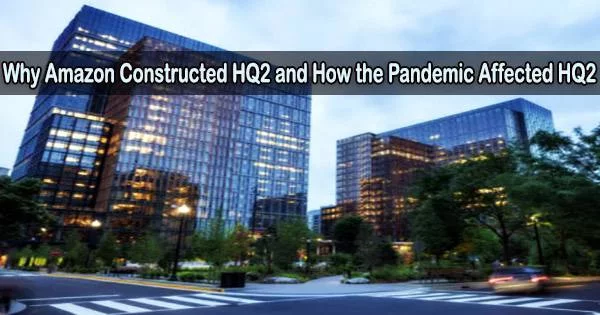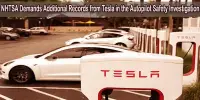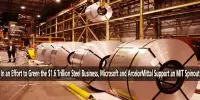Amazon launched a sweepstakes-style competition six years ago to find a location for a second headquarters. 238 states, provinces, and towns submitted proposals for the opportunity to become the new anchor for the second-largest private employer in the country and its biggest online retailer.
The first part of Amazon’s new East Coast headquarters, known as HQ2, officially opened its doors this week in northern Virginia. The first phase, called Metropolitan Park, includes two 22-story office towers, which can accommodate 14,000 of the 25,000 employees Amazon plans to bring on in Arlington. About 2,900 employees have already moved in, and Met Park will be occupied by 8,000 employees in the fall.
Amazon built its headquarters in Seattle in 1994 partly because of the area’s deep pool of tech talent and the presence of Microsoft in nearby Redmond, Washington. Tens of millions of square feet across more than 40 office buildings make up the company’s Seattle campus, and 65,000 corporate and technical Amazon employees work in the larger Puget Sound region.
It raises the question of why Amazon needed to construct a second headquarters given its expansive campus in Seattle and expanding worldwide real estate presence.
Around 2005, as Amazon’s business grew and its campus ballooned in Seattle, founder and then-CEO Jeff Bezos began to consider where the company should expand next.
At all-hands meetings, employees would ask Bezos “if we would ever be in one location at one time,” said John Schoettler, Amazon’s real estate chief, in an interview.
“I think that there was a romantic notion that we as a company would only be so big that we’d all fit inside one building,” Schoettler said. ”Bezos had said, well, we have long-term leases and when those leases come up, I’ll work with John and the real estate team and we’ll figure out what to do next.”
Originally, Bezos suggested Amazon stay around the Puget Sound area, but the conversation then shifted to recreating the “neighborhood” feel of its Seattle campus elsewhere, Schoettler said.
“We could have gone out to the suburbs and we could have taken some farmland and knocked some trees down, and we would’ve built a campus that would have been very inward-looking,” he said. “They generally have a north or south entrance and exit east or west. When you put yourself in the middle of the urban fabric and create a walkable neighborhood, an 18-hour district, you become very outward, and you become very part of the community, and that’s what we wanted.”
Holly Sullivan, Amazon’s vice president of economic development, said it would have been harder for Amazon to create that kind of environment had it “sprinkled these employees around 15 other tech hubs or 17 other tech hubs around North America.”
“So what HQ2 has provided is the opportunity for that more in-depth collaboration and being part of a neighborhood,” Sullivan said.
‘I don’t see us getting bigger in Seattle whatsoever’
Amazon’s highly publicized search for a second headquarters has faced some challenges. In 2018, Amazon announced it would split HQ2 between New York’s Long Island City neighborhood, and the Crystal City area of Arlington, Virginia. But after public and political outcry, Amazon canceled its plans to build a corporate campus in Long Island City.
Arlington residents are worried about eviction and rising housing expenses as a result of the company’s presence. The business claimed to have pledged more than $1 billion to the construction and preservation of low-cost housing in the area.
Schoettler said Amazon intends to focus much of its future growth in Arlington and in Nashville, Tennessee, where the company’s logistics hub is based. It also plans to hire as many as 12,000 people in the Seattle suburb of Bellevue, he added.
“I don’t see us getting bigger in Seattle whatsoever,” Schoettler said. “I think that we’re pretty much tapped out there.”
HQ2 has some of the same quirks as Amazon’s Seattle campus. There’s a community banana stand staffed by “banistas” and white boards on the walls of building elevators. Amazon has a dog-friendly vibe at its Seattle office, which carried over to Metropolitan Park, where there’s a public dog park, and a gallery wall of the dogs of Amazon employees. The towers feature plant-filled terraces and a rooftop urban farm that echoes the feel of the “Spheres,” botanical gardenlike workspaces that anchor Amazon’s Seattle office.
Amazon is opening HQ2 at an uncertain time for the company and the broader tech sector. Many of the biggest companies in the industry, including Amazon, have eliminated thousands of jobs and reined in spending following periods of slowing revenue growth and fears of a recession ahead.
Companies have also been confronting questions about what work looks like in a post-pandemic environment. Many workers are reluctant to go back to the workplace since they have been accustomed to working from home. The requirement that corporate employees of Amazon work from the office at least three days a week started last month, although some employees who prefer more freedom resisted the change.
Amazon tweaked the design of HQ2 around the expectation that employees wouldn’t be coming into the office every day.
Communal work spaces are more common, and there’s less assigned seating, Schoettler said. Employees may only be at a desk 30% of the day, with the rest of their time spent in conference rooms, or having casual coffee meetings with coworkers, he said.
“If we don’t come in that day, no one else will utilize the space,” Schoettler said. “And so that way, you can come in, the desk is open and it’s not been personalized with family photos and that type of thing. You can sit down and absolutely utilize the space, and then go off about your day.”
The shift to a hybrid working environment has also influenced the further development of HQ2. Amazon in March said it had pushed out the groundbreaking of PenPlace, the second phase of its Arlington campus. PenPlace is expected to include three 22-story office buildings, more than 100,000 square feet of retail space and a 350-foot-tall tower, called “The Helix,” that features outdoor walkways and inside meeting areas for employees surrounded by vegetation.
“Amazon will observe how employees work in the two new Metropolitan Park buildings to inform how it designs the offices at PenPlace,” Schoettler said.
“Amazon didn’t say when it expects to begin development of PenPlace, but it is continuing to move forward with the permitting and preconstruction process,” Schoettler said.
“We just want to be really mindful, since we’re just opening these buildings, to make sure we’re doing it right,” Sullivan said. “These are large investments for us. We own these buildings, and we want to give them a long shelf life.”
















